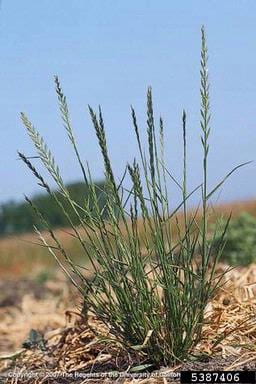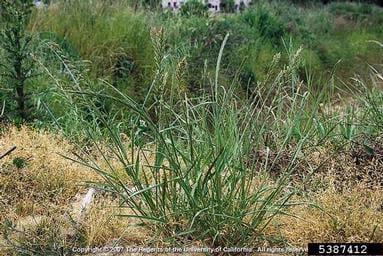Perennial ryegrass
Scientific name: Lolium perenne
Perennial ryegrass (Lolium perenne) is used for turfgrass, forage, and occasionally as a cover crop. It is a bunching grass that spreads by tillers. It is problematic in NYS in vegetable crop systems and in cover crop termination. If not managed properly, it can out-compete crops by tying up available nutrients and through allelopathy. Other cover crops (such as wheat) may be preferable. It is not drought tolerant and goes dormant in the summer months. It can cross-pollinate and produce hybrids.
Similar species
Table 11: Compares ryegrasses: Italian and perennial ryegrasses (Lolium multiflorum and Lolium perenne) and quackgrass (Elytrigia repens).
| Species | Italian ryegrass (Lolium multiflorum) | Perennial ryegrass (Lolium perenne) | Rigid ryegrass (Lolium rigidum) | Quackgrass (Elytrigia repens) |
|---|---|---|---|---|
| Similarities | Leaf bud rolled; ligule membranous; no auricles; smooth or occasional hairs on blades and lower sheath | Leaf bud rolled; ligule membranous; no auricles | Leaf bud rolled; small narrow auricles; annual like Italian ryegrass | Awns and seed heads looks like ryegrass species |
| Differences | Annual; taller than perennial ryegrass maximum height of 3 ft (1 m) and grows more vigorously; auricles are long and clasping, like claws; awns present; one basal bract; | Perennial; shorter than Italian ryegrass (12-24 in or 30-60 cm); auricles are small or malformed; awns are absent or reduced; one basal bract | Difficult to tell apart between Italian and rigid ryes as seedling; at maturity rigid rye has no awns; | Perennial; produces rhizomes; two basal bracts |
Identification
Seedlings: The leaf bud is folded.
Mature perennial ryegrass at edge of field.
Photo by Joseph M. DiTomaso of University of California–Davis, via Bugwood.org
Flowers/fruit: The flower head has spikelets.
Flower head length: 3-12 in (8-30 cm)
Spikelets of perennial ryegrass.
Photo by Joseph M. DiTomaso of University of California–Davis, via Bugwood.org
Three florets of perennial ryegrass.
Photo by D. Walters and C. Southwick, Table Grape Weed Disseminule ID, USDA APHIS PPQ, via Bugwood.org
Management
Chemical
Use CCE’s Eastern New York Horticulture’s herbicide lookup tool to find the efficacy of herbicides on a Italian ryegrass. For general guidance on weed control, get the latest edition of the Cornell Crop and Pest Management Guidelines.
Non-chemical control
Diseases: In low fertility conditions, some cultivars are prone to red thread, pink patch, and crown rust. Brown blight may be a problem, and fusarium patch and leaf spot may be an issue when there is high fertility.
Climate Change and Management
Perennial ryegrass is particularly vulnerable to heat events, becoming less competitive, especially against C4 grasses. While dense growth provides some heat tolerance, perennial ryegrass is likely to become less common in sparsely vegetated areas, potentially leading to bare ground and opportunities for other weeds to colonize.
# of studies referenced in this section: 1
Herbicide resistance in ryegrasses
Reported as of 2021:
North America
U.S.
Group 2 (2 states)
Other continents
Australia
Groups 2, 9, 10, and 11
Europe
Group 9
2-way multiple resistance to groups 1 and 2 (Denmark and Germany)
South America
Groups 1 and 9
For a more detailed report, please visit the reference section below or visit the International Herbicide-Resistant Weed Database homepage for more information on resistance.
References
For more information please look for the upcoming book, Manage Weeds on Your Farm: A Guide to Ecological Strategies by Charles L. Mohler, John Teasdale, and Antonio DiTommaso (Publisher: SARE Outreach, expected late fall of 2021).
Uva R H, Neal J C, DiTomaso J M. 1997. Weeds of the Northeast. Book published by Cornell University, Ithaca NY. The go-to for weed ID in the Northeast; look for a new edition sometime in 2019.
Cornell University has a page discussing the conditions for ryegrass (or ‘rye’) as a cover crop with control recommendations
Oregon State University has a profile page on perennial ryegrass that focuses on the Pacific Northwest as well as Turfgrass status.
For a comparison between Italian ryegrass and perennial ryegrass check out this UC IPM page.
This Q&A from Cornell University addresses ryegrass poisonings in livestock.
https://agsci.oregonstate.edu/beaverturf/perennial-ryegrass-lolium-perenne-l
For Turfgrass specific information consider this Cornell University’s resource on perennial ryegrass.
Michigan State University has an article discussing perennial ryegrass potential in Michigan as a forage crop.
White, TodD. et al. (2001) ‘Impacts of extreme climatic events on competition during grassland invasions’, Global Change Biology, 7(1), pp. 1–13. doi:10.1046/j.1365-2486.2001.00381.x.
For general guidance on weed control, get the latest edition of the Cornell Crop and Pest Management Guidelines. Since this species is generally problematic in Field Crops, you may be interested in the Guidelines specific to those crops.
Herbicide resistance details
North America
U.S.
South West: Texas, group 2 (sulfometuron-methyl)
West: California, group 2 (sulfometuron-methyl)
Other continents
Australia
New Zealand, groups 2, 9, 10, and 11 (chlorsulfuron, iodosulfuron-methyl-Na, pyroxsulam, thifensulfuron-methyl, and tribenuron-methyl, amitrole, glufosinate-ammonium, and glyphosate)
Europe
Denmark, multiple resistance to groups 1 and 2 (clodinafop-propargyl and iodosulfuron-methyl-Na); Germany, multiple resistance to groups 1 and 2 (iodosulfuron-methyl-Na, pinoxaden, and pyroxsulam); Portugal) group 9 (glyphosate)
South America
Argentina, group 9 (glyphosate); Chile, group 1 (clodinafop-propargyl, and diclofop-methyl)







